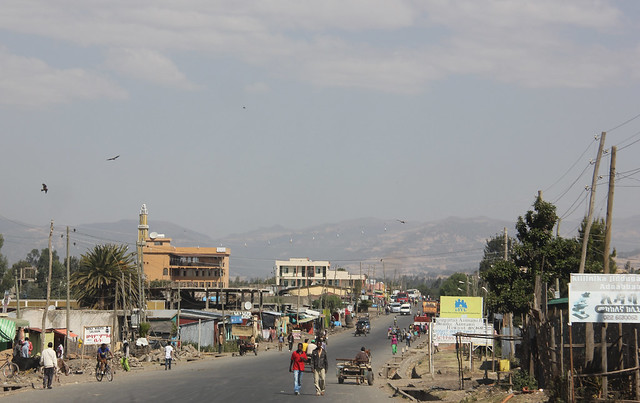5 Ways the U.S. Helps Food Insecurity in Ethiopia

Despite the fact that Ethiopia has a stronger economy than many other countries in the sub-Saharan region of Africa, it still remains one of the world’s least developed countries. In 2017, Ethiopia ranked 173 out of 189 countries and territories in the United Nations Development Programme (UNDP) Human Development Index (HDI). Food insecurity contributes to a lack of development in Ethiopia.
Drought, Conflict, and IDPs
Drought is one of the principal sources of food insecurity in Ethiopia. Ethiopia is currently suffering from the lingering effects of past droughts. There have been two devastating droughts in Ethiopia since 2015, which has forced many out of their homes in search of food and basic services. Droughts are a primary factor in the creation of internal refugees, or internally displaced person (IDPs) in Ethiopia.
Currently, nearly three million Ethiopians are categorized as IDPs. In addition to drought, the number of IDPs has increased due to a surge in ethnic violence, particularly along the Oromiya-Somali regional border. Nearly 600,000 individuals from the Oromiya and Somali regions have become IDPs.
The combination of drought, displacement, violence and underdevelopment has resulted in widespread food insecurity in Ethiopia. Due to this, roughly 7% of the population relies on food aid. The U.S. Government has been heavily involved in battling food insecurity in Ethiopia. Currently, food insecurity and under-nutrition are two of the greatest economic hindrances in Ethiopia.
Here are five things you need to know about the United States’ involvement in addressing food insecurity in Ethiopia.
5 Ways the U.S. Helps Food Insecurity in Ethiopia
- “Feed the Future,” an initiative launched by the Obama Administration in 2010, has been one of the more successful programs in promoting food security in Ethiopia: Feed the Future worked in different areas in Ethiopia from 2013 to 2015 and reduced the prevalence of poverty in those areas by 12 percent. Additionally, in 2017, those who were reached by Feed the Future generated $40 million in agricultural sales and received $5.7 million in new private investment. The economy and food security in Ethiopia are closely intertwined because the nation’s economy is dependent on agriculture. Agriculture-led economic growth, therefore, has been one the primary missions of Feed the Future within Ethiopia.
- The US has focused on restoring Ethiopia’s potato and sweet potato supply due to its high source of Vitamin A as a means of reducing food insecurity in Ethiopia: In June 2016, The USAID’s Office of US Foreign Disaster Assistance (OFDA) supported the International Potato Center (CIP) to assist drought-affected farmers in planting potatoes and sweet potatoes. Due to this support, the CIP was able to provide sweet potato seeds to nearly 10,000 farmers and trained more than 11,300 men and women on various ways to incorporate this vitamin-rich vegetable into more of their meals. The USAID/OFDA continues to support programs that promote the development of critical agriculture, such as sweet potatoes, in Ethiopia.
- Mobile Health and Nutrition Teams (MHNTs) are working in Ethiopia to help manage issues of malnutrition: The USAID’s OFDA and UNICEF have partnered together to deploy MHNTs in order to provide malnutrition screenings, basic health care services, immunizations and health education. The team also offered patient referrals when necessary. In 2017, 50 MHNTs provided 483,700 individuals in the Afar and Somali regions of Ethiopia with life-saving health and nutritional services.
- Humanitarian assistance has been essential in reducing severe acute malnutrition (SAM) in children: Although USAID provides resources to help treat SAM, 38 percent of children under five still have stunted growth due to malnutrition. As of March 2018, 31,066 children were admitted and treated for SAM. Approximately 30 percent of these cases were in the Somali region due to the region’s issue with ethnic violence and drought. Significantly more assistance is needed in the Somali region in order to sufficiently manage malnutrition.
- Humanitarian assistance has been one of the primary reasons Ethiopia has not entered into a state of emergency for food insecurity: Although increased rainfall and a reduction in disease outbreak have helped minimize food insecurity in Ethiopia, the country would be much worse off without the help of humanitarian aid. Currently, Ethiopia is in crisis, which is phase three of five on the food insecurity scale. The phases include minimal, stressed, crisis, emergency and famine. Experts from the Famine Early Warning Systems Networks report that “Ethiopia would likely be at least one phase worse without current or programmed humanitarian assistance.”
Looking Forward
The need for humanitarian aid will increase as Ethiopia’s population rapidly grows. Currently, Ethiopia ranks second in Africa for the number of refugees the country hosts. Nearly 100 percent of these refugees originate from South Sudan, Somalia, Eritrea and Sudan. Ethiopia currently hosts over 920,262 registered refugees and asylum seekers as of May 31, 2018.
The number of asylum seekers in Ethiopia will continue to grow because Ethiopia has an open-door asylum policy. As Ethiopia’s population continues to grow due to this policy, food sources will become increasingly strained. The need for humanitarian assistance to promote sustainable agriculture and farming practices, therefore, has become essential for reducing food insecurity in Ethiopia.
– Ariana Howard
Photo: Flickr
